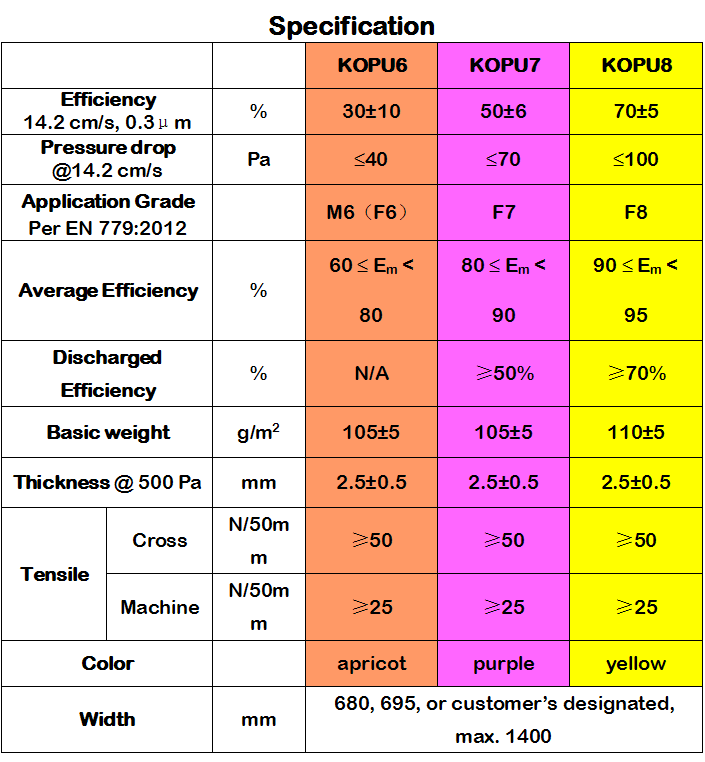Developed by 4G, KOPU is air filter media for manufacturing pocket filters used in general ventilation.
 In KOPU media, the major filtration layer is traditional fiberglass. On top of fiberglass, a pre-filter layer is laminated. This front layer serves two functions. Firstly, it increases Test Dust Capacity, or TDC. This implies that filters of KOPU media will shows a longer service-life. Secondly, this thick and strong layer protect the traditional fiberglass and make the filter media handling friendly.
In KOPU media, the major filtration layer is traditional fiberglass. On top of fiberglass, a pre-filter layer is laminated. This front layer serves two functions. Firstly, it increases Test Dust Capacity, or TDC. This implies that filters of KOPU media will shows a longer service-life. Secondly, this thick and strong layer protect the traditional fiberglass and make the filter media handling friendly.
Compared with traditional fiberglass, KOPU has the following advantages and disadvantages:
Advantage — Handling-friendly
Traditional fiberglass media is quite fragile and easily tear off. Filter manufacturers have to hire experienced workers to assemble filters with special care, and end users have to hire trained workers to do filter installation. With a protection layer, KOPU media and filters of KOPU media are no longer fragile. This may take off half of customer’s headaches in dealing with fiberglass.
Advantage — Formaldehyde-free
Our competitors use formaldehyde based binders in fiberglass media. Such glues may have a danger in outgassing formaldehyde. Binders used by 4G contains and outgas hardly any formaldehyde.
Advantage — Long service-life
A carefully chosen top layer serves as a pre-filter layer to protect fiberglass. Pocket filters made of COPU may give a longer service-life compared with the traditional fiberglass, depending on filter designs and applications.
Disadvantage — Reduced fire resistant
Compared with traditional fiberglass, KOPU media contains an extra flammable pre-filter layer. So it may have a lower fire-proof grade. It can be improved by special fire-proof treatment, but with an increasing production costs.
Disadvantage — Less competition
Customers love to squeeze a list of suppliers to get good quality products with a good price. Unfortunately, it is not the case when they try to source fiberglass media for pocket filters. Including the new comer 4G, there are probably only four manufactures.
Disadvantage — Reduced speed for stitching
There are some hot-melt in COPU. High temperature due to high speed stitching may cause blocked needle holes. It is recommended that stitching speed does not exceed 6 m/min. Higher speed may need extra vent at needles.


Efficiency and pressure drop are tested at 85 L/dm2/min. Other test parameters can be applied according customers’ specification.
Application grade refers to the filter classification per EN779:2012. It should be noted that commonly designed filters will march such an ‘application grade’ in lab testing, while some uncommon designs and uncommon test conditions may give a lower or upper grade.
Test Average Efficiency refers to the average efficiency during loading test per EN 779:2012 or Chinese CRAA432.1-2008.
Discharged Efficiency is a criterion specified by EN779:2012. It is an efficiency after discharge, minimum 35% for F7 filter and 55% for F8. M6 filters do not require any discharge test.
Thickness is merely for production control. Different pressure when measuring will give different thickness.
Color gives standard colors. 4G can provide media with customer designated colors.
In manufacturing bag filters, a special designed stitching machine is needed. To help customers who do not have a stitching machine, 4G can provide ready stitched filter bags.
4G promised that it only makes filter media, no any assembled filter, i.e. never competing with customers.

